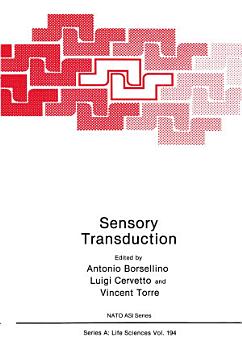Sensory Transduction
Antonio Borsellino · Luigi Cervetto · Vincent Torre
ທ.ວ. 2012 · NATO Science Series A ຫົວທີ 194 · Springer Science & Business Media
ປຶ້ມອີບຸກ
290
ໜ້າ
reportບໍ່ໄດ້ຢັ້ງຢືນການຈັດອັນດັບ ແລະ ຄຳຕິຊົມ ສຶກສາເພີ່ມເຕີມ
ກ່ຽວກັບປຶ້ມ e-book ນີ້
Present knowledge of the mechanisms underlying any single sensory modality is so massive as to discourage effort directed towards completeness. The idea underlying the structure of this volume on "Sensory transduction" was to select just a few topics of general interest, which are currently being investigated and for which a reasonably clear picture is now available. During the last five years there has been a revolution in the way sensory physi ologists think about transduction, and a series of exciting advances have been made in understanding the basic processes of photo transduction, chemotransduction and mechan otransduction. It is clear that in many cases the fundamental processes by which nature attains optimization of performance are similar, and that they have much in common with more general processes of signal recognition by living structures. The molecular events underlying the detection of photons by visual cells, the recognition of a given molecule by a chemoreceptor, or the level of a hormone in the extracellular fluid by a target cell, are all very similar, and involve the activation of a sequence of events leading to a secon d messenger. The 20 papers that form the present volume cover various topics in the field of sensory transduction. They originate from the lectures, seminars and discussions which made up the XVIII Course of the International School of Biophysics held in Erice, 9th - 19th June 1988.
ໃຫ້ຄະແນນ e-book ນີ້
ບອກພວກເຮົາວ່າທ່ານຄິດແນວໃດ.
ອ່ານຂໍ້ມູນຂ່າວສານ
ສະມາດໂຟນ ແລະ ແທັບເລັດ
ຕິດຕັ້ງ ແອັບ Google Play Books ສຳລັບ Android ແລະ iPad/iPhone. ມັນຊິ້ງຂໍ້ມູນໂດຍອັດຕະໂນມັດກັບບັນຊີຂອງທ່ານ ແລະ ອະນຸຍາດໃຫ້ທ່ານອ່ານທາງອອນລາຍ ຫຼື ແບບອອບລາຍໄດ້ ບໍ່ວ່າທ່ານຈະຢູ່ໃສ.
ແລັບທັອບ ແລະ ຄອມພິວເຕີ
ທ່ານສາມາດຟັງປຶ້ມສຽງທີ່ຊື້ໃນ Google Play ໂດຍໃຊ້ໂປຣແກຣມທ່ອງເວັບຂອງຄອມພິວເຕີຂອງທ່ານໄດ້.
eReaders ແລະອຸປະກອນອື່ນໆ
ເພື່ອອ່ານໃນອຸປະກອນ e-ink ເຊັ່ນ: Kobo eReader, ທ່ານຈຳເປັນຕ້ອງດາວໂຫຼດໄຟລ໌ ແລະ ໂອນຍ້າຍມັນໄປໃສ່ອຸປະກອນຂອງທ່ານກ່ອນ. ປະຕິບັດຕາມຄຳແນະນຳລະອຽດຂອງ ສູນຊ່ວຍເຫຼືອ ເພື່ອໂອນຍ້າຍໄຟລ໌ໄໃສ່ eReader ທີ່ຮອງຮັບ.








